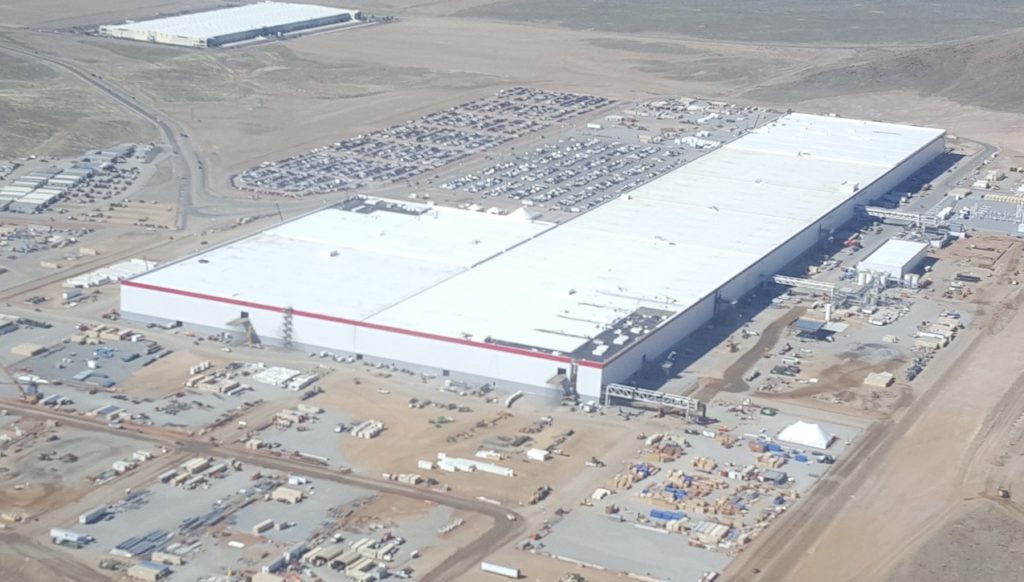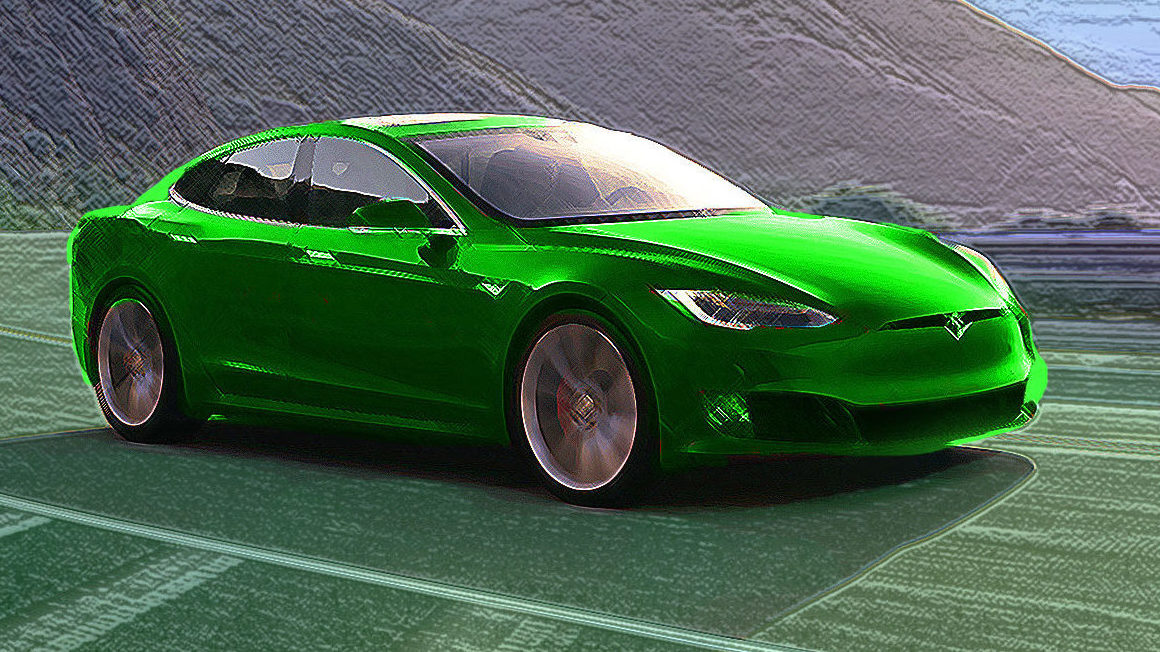
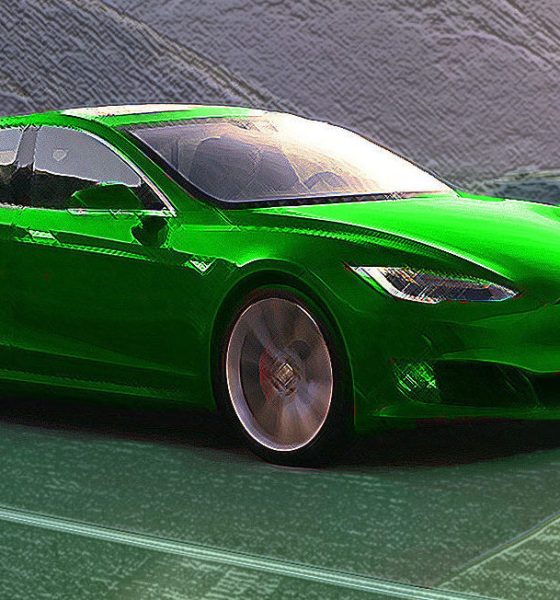
Lifestyle
A Tesla is greener than you think and getting greener – a look at manufacturing
An electric vehicle is more than just a new form of technology. It’s part of a shift in our entire way of life. From a consumables based civilization to a renewable one. My last article focused on the environmental benefits of driving an electric vehicle, but what about manufacturing? Is it also sustainable?
One of the main themes from my previous article is that the data surrounding electric vehicles has been quickly changing. Our electricity grid is getting greener, batteries are increasing in energy density, and costs are falling. This rapid advancement is the reason for many misconceptions about electric vehicles and it holds true of manufacturing as well. This article dives into the manufacturing impact, to give you a better feel for its significance, and show how much better it can get.
First though I want to be clear, an electric vehicle is without a doubt the better environmental choice. To get a good snapshot of this just take a look at the lifecycle greenhouse gas emissions in the graph below. These emissions include everything from raw material extraction, to vehicle manufacturing, through operation, and finally to end of life. It’s clear that the reductions from driving far exceed any emissions from vehicle production. The savings are huge.
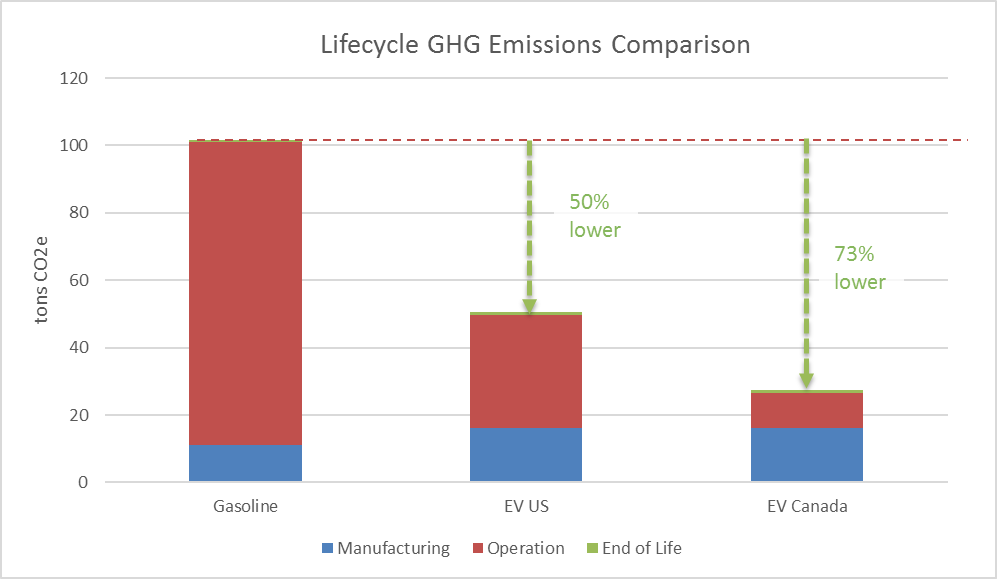
*Based on 180,000 miles of lifetime driving of a large electric sedan (85kWh), batteries manufactured in China, vehicles made in Germany or USA, IPCC median data of lifecycle emissions factors for electricity sources, 2016 electricity source mix from Canada and the USA for EV charging, and EPA data for a 26 mpg vehicle.
But what is the manufacturing based on you say? A fair question. Manufacturing emissions depend on many factors like: which materials are used, the source of those materials, technologies incorporated into the manufacturing processes, material transportation needs, and the type of energy used at each stage of production. The manufacturing data in the graph above is based on batteries produced on a carbon intensive grid (like China) with final vehicle assembly in Germany or the US. For a large 85kWh Tesla battery weighing around 550 kg, the battery would account for 6 tons of greenhouse gas emissions. I’ve seen this as the typical scenario in many research papers but with electricity grids getting cleaner every year the data quickly falls out of date. Still, it serves as a good baseline scenario. You may have seen higher numbers reported elsewhere, but frankly they are based on old data and often use the poor metric of kgCO2e/kWh, which doesn’t hold true as energy density rapidly improves. A better metric is kgCO2e/kg of battery but even that must be continually updated.
What may not be immediately clear from the graph, is that the savings from driving an electric vehicle will very quickly payback the emissions from manufacturing the entire vehicle. In Canada the payback would occur after about 55,000 kms, and the USA at 77,000 kms. So, if you’re already driving, the most environmentally friendly thing you can do is replace your combustion vehicle with an electric vehicle today!
That’s great…..but can we do better?
Remember that the blue bar in the graph assumes batteries are made in China and the vehicles are made in Germany or the USA. Not exactly low carbon electricity grids. It’s also based on studies using electricity data already a few years old and doesn’t account for the specific manufacturing facilities that are already better than the average electricity grids in those countries. Many manufacturers have also incorporated on site renewable energy and better recycling practices.
Manufacturer Highlights
- Tesla currently manufacturers vehicles in California and batteries in Nevada. The Nevada battery Gigafactory will be 100% renewably powered with a 70MW solar array and have on site recycling. The Freemont California grid is actually already very clean with 70% from non-fossil fuels (which partially explains the lack of solar there).
- Chevy’s Bolt is manufactured by GM in Michigan. 54% of the facility’s energy comes from a combination of a 350kW solar array and landfill gas. The batteries are made by LG batteries in Holland Michigan, predominately powered by a natural gas power plant. There is no solar integration in that LG facility but satellite imagery appears to show solar installed on some of their international facilities (oddly this is not mentioned in their sustainability reports). GM also has a plan to use 100% renewable energy by 2050 but that’s almost meaningless because almost everything should be 100% renewably powered by then or we’re going to be in big trouble.
- The Ford Focus EV is also made in Michigan factory which incorporates a 500kW solar array. Their batteries are also made by LG.
- Nissan has a solar array on the Leaf factory in Japan, but they don’t have one on the USA factory. Their batteries are also made by LG.
That’s a good look at today but manufacturers will continue to improve. In fact that’s a recurring theme in all my research, that what was true 5 years ago for electric vehicles is not the reality today and that in turn won’t be representative of the future. Electricity is getting cleaner, cars are getting lighter, recycling is improving, and batteries are becoming more energy dense. All of this makes manufacturing an EV more sustainable. The big question is how quickly and how much can they improve?
There are a variety of papers published on how individual factors can benefit the sustainability of electric vehicle manufacturing. What I’ve done is combine the impacts, as graphed below. The key takeaway from the graph is that Tesla, and possible others, are making EVs with low embodied manufacturing emissions and that this will only improve as time goes on.
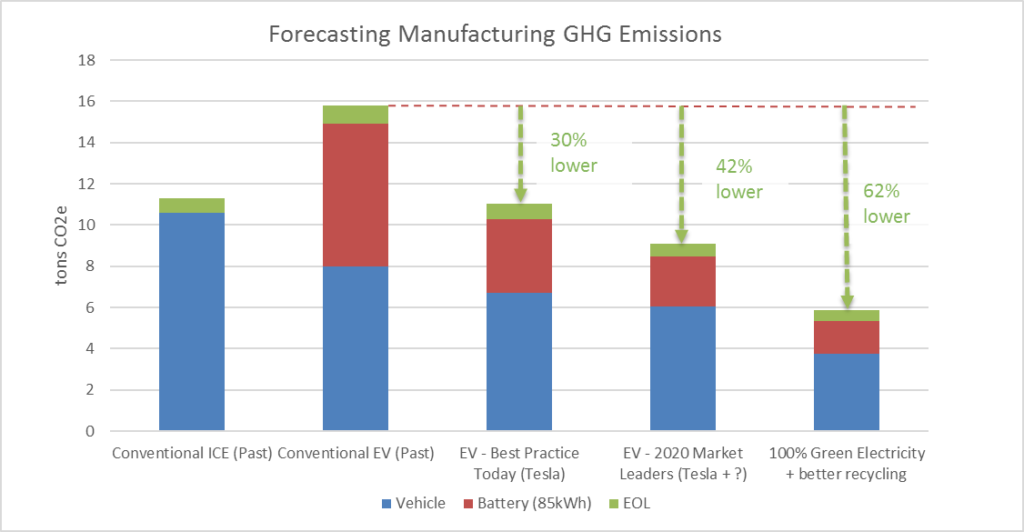
The graph compares the emissions from conventional manufacturing practices for a large combustion sedan and a large EV sedan, and then compares that to sustainability leaders like Tesla today, in 2020, and then into the future. Please remember this is representative data based on many research reports, manufacturing practices, battery density forecasts, some estimations of future conditions, and some interpolation of data.
How are these results achieved?
1: Selecting Clean Electricity Sources
Electricity is used extensively to produce both the materials used in vehicles and the assembled vehicles themselves, but there’s a huge variation in how ‘clean’ electricity grids are. China, Germany, and Michigan, are all locations big on vehicle manufacturing. China also has a huge chunk of the world’s battery production and will continue to do so. By 2020, worldwide production capacity is expected to expand five-fold, with China and South Korea producing 75% of world’s batteries.
In China coal use is down but still accounts for over 60% of electricity production, while in the USA it’s been dropping even faster, now at 30%. Germany, South Korea, and Michigan still get about 40% of their electricity from coal. Coal is a dirty fuel and manufacturers should avoid it to improve their sustainability. Then there’s the issue of climate change, driven by greenhouse gas emissions. Even though natural gas is cleaner to burn than coal, it still creates a lot of greenhouse gas and is responsible for significant methane leaks. For comparison purposes I’ve graphed the greenhouse gas emissions factors for relevant electricity grids and highlighted some specific manufacturer information to account for on-site renewable energy. It makes for an interesting comparison, showing that both the Chevy Bolt and Tesla facilities use electricity sources far greener than even their state grids.
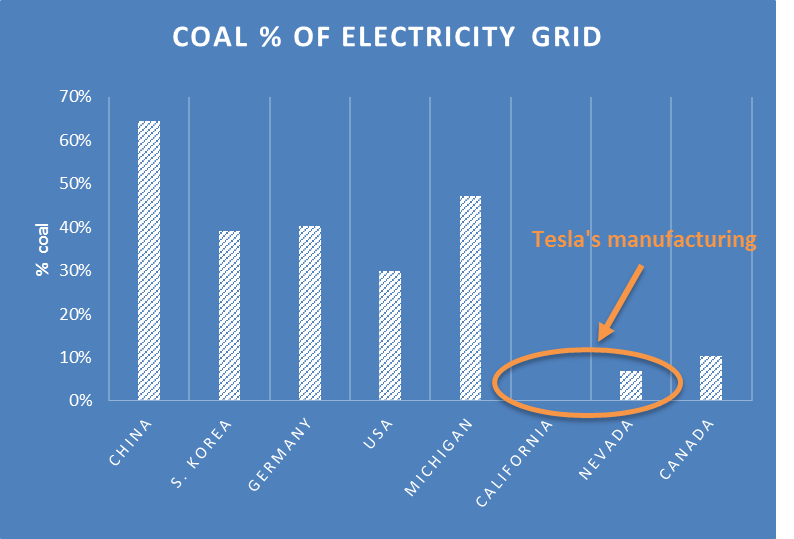
Why is coal considered dirty? Consider that natural gas produces approximately 50% less GHG emissions than coal, 99% less SOx, 90% less NOx, and 99% less particulates.
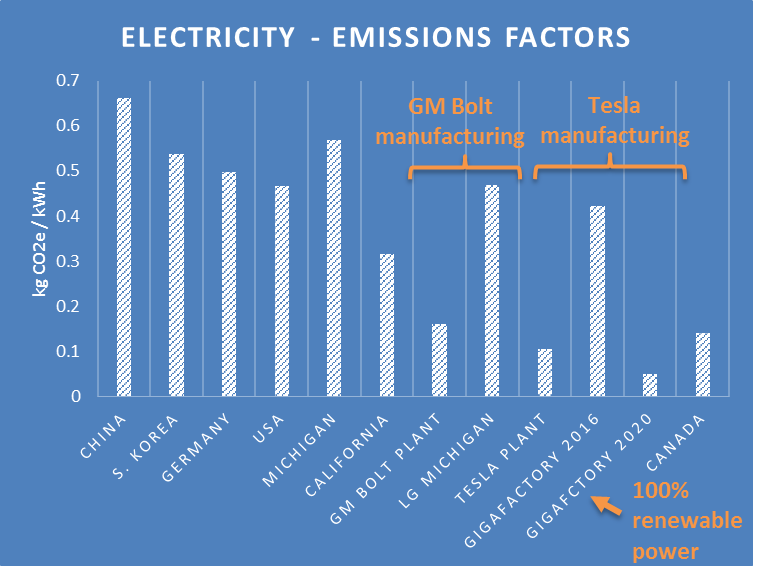
Data uses IPCC median emissions factors for electricity sources, not emission data from the individual plants or regions. It’s important to recognize that many of the components are not made by GM or Tesla at the facilities noted (i.e. airbags, engine blocks, etc). Electricity contributes 29% of the greenhouse gas emissions in the USA and industry is responsible for 21%. That means there’s a lot of room for manufacturing to go green with low-carbon electricity.
Look at the Gigafactory in 2020, what a difference a green electron makes! A recent study from the Norwegian University of Science and Technology found that using renewable electricity could drop production emissions by more than half. That’s for an entire Tesla Model S sized vehicle. With Tesla on the verge of expanding their manufacturing into China, it would be both surprising and disappointing if they didn’t make all new factories 100% renewably powered. It is the new benchmark that they themselves have set for sustainable manufacturing.
2: Light-weighting
You may have noticed a lot of manufacturers using more aluminum in their vehicles. There’s good reason for this. An aluminum body can be 40% lighter than a steel body, according to Audi, and Tesla’s Model S and X use aluminum exclusively in their construction. The push for longer range EVs is resulting in a push for lighter weight vehicles that use less materials. That’s great for the environment.
3: Longer Lasting Cars and Materials
Electric vehicles will last longer than conventional combustion cars today. Aluminum doesn’t rust, electric cars have far fewer moving parts to wear out and few disposable fluids to maintain, and the vehicles get over-the-air updates. But eventually they will wear-out, and this is where recycling comes in.
4: Recycling
Today material recovery rates for steel and aluminum in vehicles are very high, at about 90%. For aluminum this is a big deal because recycled aluminum uses only 5% of the electricity for processing, compared to processing from raw materials. I reached out to Tesla to get information on how much recycled content they use and where their aluminum comes from but they’ve yet to get back to me.
Batteries also benefit from recycling as they are composed mostly of valuable metals like aluminum, copper, nickel, cobalt, and lithium (there’s also the graphite anode to consider). Studies indicate a possible 50% reduction in total battery emissions from recycling. Tesla’s current battery recycler in Europe, Umicore, states that through their recycling they can already recover 70% of the GHG emissions that were produced during the original material extraction and refining stages. Large scale lithium-ion battery recycling won’t be needed for several years. Batteries today are expected to last a decade or more and that is continually improving. Just recently Tesla’s battery research division achieved a doubling of battery lifespans for NMC batteries used in their energy storage (their cars use the NCA chemistry). That was just one year into their work.
Imagine a vehicle that was produced entirely from recycled materials using 100% renewable energy, powered by renewable energy, driving quietly down the road with zero pollution. That’s the future. A truly closed loop, because once the materials are extracted, they can be used again and again. It’s not like gasoline which is used only once.
5: Ethical and local sourcing
The results discussed so far have included the emissions from extracting and processing materials, but what about the ethical and moral considerations? Ensuring that vehicles are produced ethically should be required of every manufacturer. Most of the manufacturers have ethical material sourcing reports, to varying degrees of diligence, and some is mandated of publicly traded companies. Tesla has also reaffirmed their commitment to ethically and locally sourced materials, on a number of occasions.
“Imagine a vehicle that was produced entirely from recycled materials using 100% renewable energy, powered by renewable energy, driving quietly down the road with zero pollution. That’s the future.”
Cobalt and graphite are potentially two of the biggest issues right now. Today 65% of the world’s cobalt comes from the Democratic Republic of Congo and most of the flake natural graphite is coming from China. Using less of these contentious materials is a good place to start. The NCA battery chemistry used by Tesla/Panasonic requires far less cobalt than the NMC chemistry commonly used by other manufacturers. They have also committed to sourcing cobalt from non-conflict zones. Canada seems to have a role to play here. Canada sits third in world production of cobalt and third in nickel production. It’s not a coincidence as cobalt is often the byproduct of nickel production. For graphite Tesla has previously stated that artificially produced graphite from Europe may be used and there are other anode materials in development.
Lithium is probably the most discussed material but accounts for ~10% of the battery by weight. It is overwhelmingly extracted from salt brines, pumped from under dried up salt flats in politically stable countries. It’s a pretty clean process but I do have issue with the evaporation process, as it depletes groundwater aquifers. Thankfully there are companies working to create new processes that don’t rely on evaporation to concentrate the minerals. But even with current methods, extracting a recyclable material like lithium has to be better than fracking for a consumable product like oil.
Conclusion:
Manufacturing electric vehicles today is comparable to or better than a combustion vehicle. This will only get better, especially if it’s something customers care about. It’s time to look beyond operational benefits and pay attention to which manufacturers are sustainability leaders. Vote with your dollars and call on manufacturers to make positive changes.
Tesla is undoubtedly one of the leaders. They are using clean electricity in their production today and their massive battery Gigafactory will be 100% renewably powered once complete. Their batteries have a low environmental impact relative to their peers due to the material composition, high energy densities, and clean electricity used in production. They are also have good recycling practices and will improve that with on-site battery recycling in the future. Their cars are long lasting, made of lightweight materials, and they have a good material sourcing strategy. If they can continue to be leaders in this way and push the industry forward, it may just transform all of manufacturing. That’s not to say Tesla is the only one. There are other manufacturers doing some of these good things, but no one seems to be as thorough or have the complete vision of the best possible future like Tesla does. But hey, if those other manufacturers can prove me wrong, all the better.

Lifestyle
Tesla Model S Plaid battles China’s 1500 hp monster Nurburgring monster, with surprising results
There is just something about Tesla’s tuning and refinement that makes raw specs seem not as game-changing.

The Tesla Model S Plaid has been around for some time. Today, it is no longer the world’s quickest four-door electric sedan, nor is it the most powerful. As per a recent video from motoring YouTube channel Carwow, however, it seems like the Model S Plaid is still more than a match for some of its newer and more powerful rivals.
The monster from China
The Xiaomi SU7 Ultra is nothing short of a monster. Just like the Model S Plaid, it features three motors. It also has 1,548 hp and 1,770 Nm of torque. It’s All Wheel Drive and weighs a hefty 2,360 kg. The vehicle, which costs just about the equivalent of £55,000, has been recorded setting an insane 7:04.957 at the Nurburgring, surpassing the previous record held by the Porsche Taycan Turbo GT.
For all intents and purposes, the Model S Plaid looked outgunned in Carwow’s test. The Model S Plaid is no slouch with its three motors that produce 1,020 hp and 1,420 Nm of torque. It’s also a bit lighter at 2,190 kg despite its larger size. However, as the Carwow host pointed out, the Model S Plaid holds a 7:25.231 record in the Nurburgring. Compared to the Xiaomi SU7 Ultra’s record, the Model S Plaid’s lap time is notably slower.
Real-world tests
As could be seen in Carwow’s drag races, however, Tesla’s tech wizardry with the Model S Plaid is still hard to beat. The two vehicles competed in nine races, and the older Model S Plaid actually beat its newer, more powerful counterpart from China several times. At one point in the race, the Xiaomi SU7 Ultra hit its power limit due to its battery’s temperature, but the Model S Plaid was still going strong.
The Model S Plaid was first teased five years ago, in September 2020 during Tesla’s Battery Day. Since then, cars like the Lucid Air Sapphire and the Xiaomi SU7 Ultra have been released, surpassing its specs. But just like the Model Y ended up being the better all-rounder compared to the BYD Sealion 7 and the MG IM6, there is just something about Tesla’s tuning and refinement that makes raw specs seem not as game-changing.
Check out Carwow’s Model S Plaid vs Xiaomi SU7 drag race video below.
Lifestyle
500-mile test proves why Tesla Model Y still humiliates rivals in Europe
On paper, the BYD Sealion 7 and MG IM6 promised standout capabilities against the Model Y.

BYD is seeing a lot of momentum in Europe, so much so that mainstream media has taken every opportunity to argue that the Chinese automaker has beaten Tesla in the region. But while BYD sales this year in Europe are rising and Tesla’s registrations remain challenged, the raw capabilities of vehicles like the Model Y are difficult to deny.
This was highlighted in a 500-mile challenge by What Car? magazine, which showed that the new Tesla Model Y is more efficient, cheaper to run, and more reliable than rivals like the BYD Sealion 7, and even the nearly 400 KW-charging MG IM6.
Range and charging promises
On paper, the BYD Sealion 7 and MG IM6 promised standout capabilities against the Model Y. The Sealion 7 had more estimated range and the IM6 promised significantly faster charging. When faced with real-world conditions, however, it was still the Model Y that proved superior.
During the 500-mile test, the BYD nearly failed to reach a charging stop, arriving with less range than its display projected, as noted in a CarUp report. MG fared better, but its charging speeds never reached its promised nearly-400 kW charging speed. Tesla’s Model Y, by comparison, managed energy calculations precisely and arrived at each stop without issue.
Tesla leads in areas that matter
Charging times from 25% to 80% showed that the MG was the fastest at 17 minutes, while Tesla and BYD were close at 28 and 29 minutes, respectively. Overall efficiency and cost told a different story, however. The Model Y consumed 19.4 kWh per 100 km, compared to 22.2 for MG and 23.9 for BYD. Over the full trip, Tesla’s charging costs totaled just £82 thanks to its supercharger network, far below BYD’s £130 and MG’s £119.
What Car? Magazine’s testers concluded that despite BYD’s rapid sales growth and the MG IM6’s seriously impressive charging speeds, Tesla remains the more compelling real-world choice. The Model Y just offers stability, efficiency, and a proven charging infrastructure through its Supercharging network. And as per the magazine’s hosts, the Model Y is even the cheapest car to own among the three that were tested.
Watch What Car? Magazine’s 500-mile test in the video below.
Lifestyle
Tesla Cybertruck slapped with world’s least intimidating ticket, and it’s pure cringe
One cannot help but cringe and feel second-hand embarrassment at the idea of a person just driving around with a stack of these babies.

A Cybertruck parked at Stanford Shopping Center in California was recently hit with what might be the most try-hard piece of paper ever slipped under a wiper blade: a “fake citation” accusing the driver of supporting a “fascist car.”
The note, shared on X by Tesla staff program manager Ryan Torres, quickly made the rounds on X, where it quickly gained attention as an example of how not to protest.
The world’s least intimidating ticket
According to the citation, the supposed “violation” was “driving a fascist car.” The remedial action? Take the bus, call an Uber, or ride a bike. The note also dubbed Elon Musk a “chainsaw-wielding Nazi billionaire.” Now, protests against Tesla and Elon Musk have become commonplace this year, but one cannot help but cringe and feel second-hand embarrassment at the idea of a person just driving around with a stack of fake anti-Tesla/Musk citations.
Torres pointed out the irony himself in his post on X. Tesla currently employs over 140,000 Americans, and SpaceX has put the U.S. firmly back at the top of space technology. As Torres put it, maybe the person behind the world’s least intimidating ticket should “read a book on innovation before vandalizing” other people’s property.
Peak performative clownery
Not to mention that the fake ticket’s logic collapses under its own weight. EVs like the Cybertruck are literally designed to reduce emissions, not “destroy the economy.” If anything, Tesla has bolstered the United States’ economy by fueling jobs in engineering, manufacturing, and clean energy. It’s not the first time a Tesla has been the target of vandalism or politically charged notes, but this one stands out for sheer cringe value.
Torres summed it up neatly: “Peak clownery.” On that point, at least, the citation earns full marks. In a way, though, perhaps cringe fake tickets are not as bad as the literal firebombs that were being thrown at Tesla stores and cars earlier this year because some critics were gleefully misinformed about Elon Musk.
